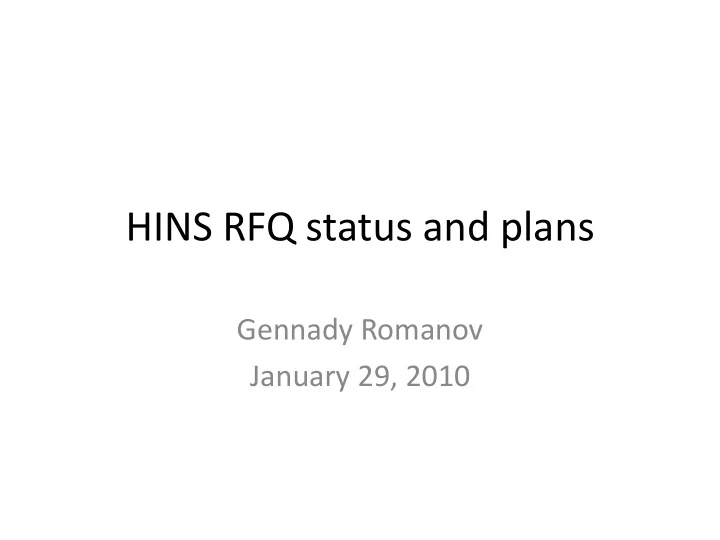

HINS RFQ status and plans Gennady Romanov January 29, 2010
RFQ description The radio frequency quadrupole (RFQ) accelerator began as “The ion linear accelerator with space- uniform strong focusing” conceived by I. M. Kapchinskii and V.A. Teplyakov. In April-May of 1975 a 4-rod RFQ was started up at theInstitute of High- Energy Physics in the USSR. 1/29/2010 Gennady Romanov 2
Building RFQ . Design steps. Beam dynamic design. Now it’s normal step Parameters of electrode modulation. Analytical fields. RF design. Electromagnetic design Beam simulations of RFQ resonator. Ideal RF fields (TRACK in our case) Recently done at ANL Mechanical design, manufacturing, Nobody did RF tuning. Field measurements. 1/29/2010 Gennady Romanov 3
Beam dynamic design It has been done for Fermilab by ANL. The main accelerating parameters and tables for vane tip modulation have been developed. Vane tip modulation TRACK simulations have been performed and output beam parameters for different beam currents have been defined 1/29/2010 Gennady Romanov 4
Initial RF design, mechanical design, manufacturing and RF tuning. All have been done by AccSys, Pleasantville, CA. Mechanical alignment RF tuning 1/29/2010 Gennady Romanov 5
Correction of RF design, mechanical changes and re-tuning Conference Call on 14 th of December with FERMILAB personnel Meeting date: 14 December 07 ….. The current status of the resonator for project 212 as of 14 December 07 The assembly of the resonator has been completed. However, during the initial tuning of the resonator AccSys personnel were unable to correct (flatten) the resonators quadrupole field. A number of attempts were made to bring the quadrupole field into a standard curve for tuning. …. High energy cut-back and intervane gaps have been changed 2% flatness 1/29/2010 Gennady Romanov 6
Beam acceleration in RFQ Note: The RFQ has been sent back to AccSys twice because of different failures. Last time it has been disassembled, but no re-tuning and no accurate field measurements have been done. The only reliable information is that the field unflatness doesn’t exceed 5% now. 1/29/2010 Gennady Romanov 7
Time of Flight – Sparked RFQ • Toriod • Up BPM • Down BPM From Vic Scarpine’s presentation ~ 45 ns • Up BPM • Down BPM 1/29/2010 Gennady Romanov 8
From Vic Scarpine’s Profile Sigmas ; I ~ 4 mA presentation Horizontal Vertical Diagonal Scanner 1 4.5 mm 4.2 mm 4.3 mm Scanner 2 7.0 mm 6.8 mm 6.2 mm Scanner 3 16.2 mm 13.2 mm 13.4 mm 3.5 TRACK simulation with beam Xrms WS 3 normalized rms emittance Yrms WS increased up to 0.37 mm mrad XYrms WS 2.5 Rrms TRACK Beam size, cm ( 0.255 mm mrad design value). Big 2 Rmax TRACK dots – wire scanner positions and 1.5 measurements. Beam phase 1 ellipses orientation is the same. There are 3% losses in the beam 0.5 pipe of 1.74 mm radius. 0 0 20 40 60 80 100 120 140 160 180 Distance from RFQ, cm 1/29/2010 Gennady Romanov 9
Current activity We are planning another round of 2.5 MeV beam operation this Monday afternoon (Feb 1). The radiation safety officer will arrive at 1:00 pm, so we should be ready to open the beam stops before they arrive. The plan is to focus on ion source tuning for better efficiency through the RFQ. We may also explore means to better measure beam energy through the BPMs. Jim Steimel 1/29/2010 Gennady Romanov 10
Recommend
More recommend